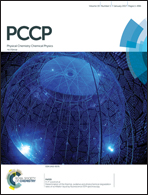CeO2-modified α-MoO3 nanorods as a synergistic support for Pt nanoparticles with enhanced COads tolerance during methanol oxidation†
Abstract
A new type of Ce-doped α-MoO3 (Ce0.2Mo0.8O3−δ) nanorod support was synthesized using a two-step hydrothermal method. The mixed oxide solid solution was employed as a novel non-carbon support for Pt catalysts used for the methanol electrooxidation in acidic media. The ratio of Ce to Mo in the solid-solution was systematically optimized in terms of the performance as a support for methanol oxidation. Pt nanoparticles with an average diameter of 2 nm were evenly deposited on Ce0.2Mo0.8O3−δ nanorods. Compared to the Pt/MoO3 and commercial Pt/C catalysts, the optimal Pt/Ce0.2Mo0.8O3−δ catalyst exhibited significantly enhanced COads tolerance during the methanol oxidation, thereby yielding the highest electrocatalytic activity and stability. The improved electrochemical performance can be ascribed to strengthened metal–support interactions derived from the high number of oxygen vacancies on Ce0.2Mo0.8O3−δ along with its unique one-dimensional nanorod structure. In addition, these findings suggest that the doping-induced structural and size transition of MoO3 could provide a new pathway to develop doped oxides capable of providing sufficient electrical conductivity and possible synergistic effects with other active components for electrocatalysis applications.


 Please wait while we load your content...
Please wait while we load your content...